COMPLEMENTARY & ALTERNATIVE MEDICINE
VerifiedAdded on 2022/09/11
|7
|2101
|19
AI Summary
Contribute Materials
Your contribution can guide someone’s learning journey. Share your
documents today.
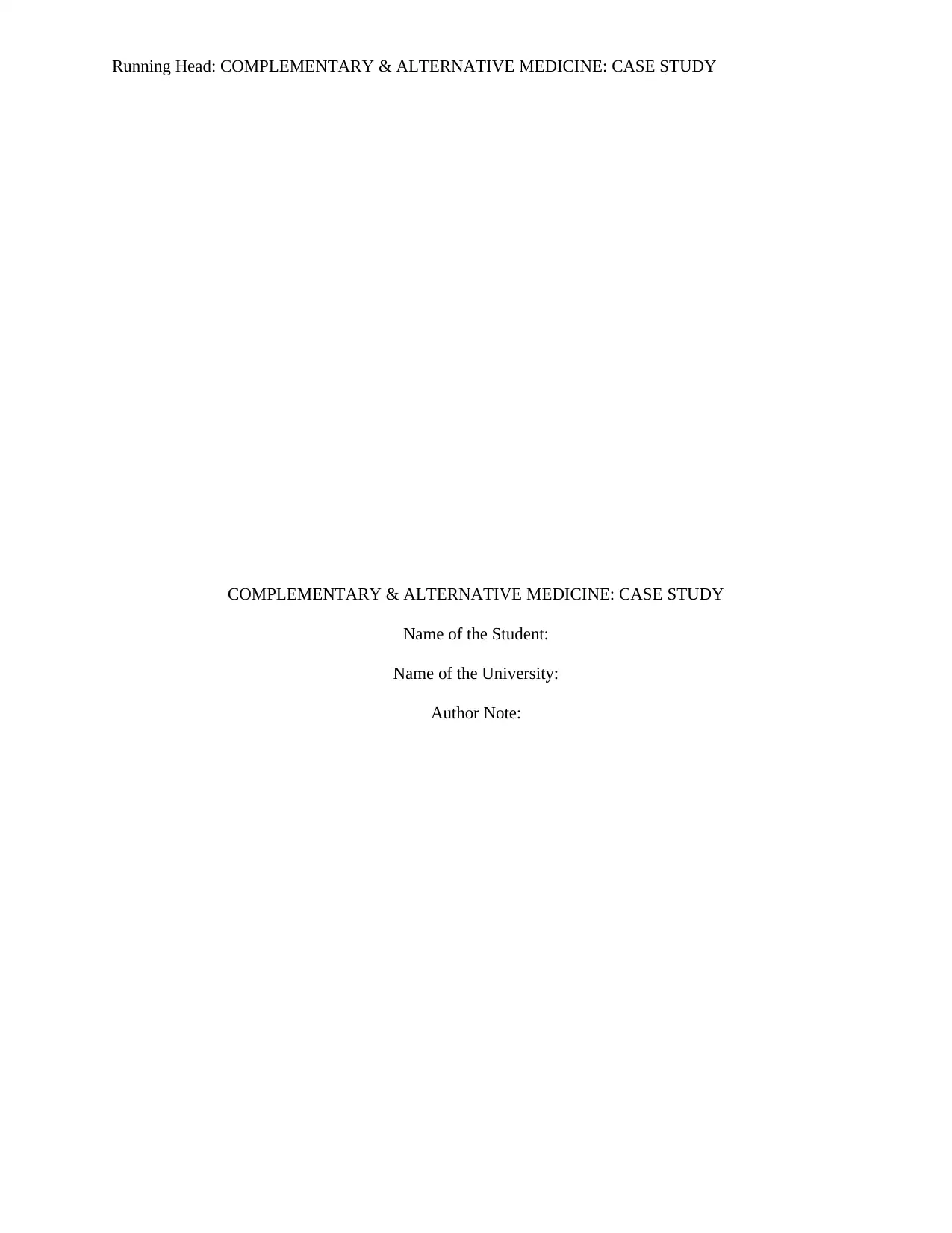
Running Head: COMPLEMENTARY & ALTERNATIVE MEDICINE: CASE STUDY
COMPLEMENTARY & ALTERNATIVE MEDICINE: CASE STUDY
Name of the Student:
Name of the University:
Author Note:
COMPLEMENTARY & ALTERNATIVE MEDICINE: CASE STUDY
Name of the Student:
Name of the University:
Author Note:
Secure Best Marks with AI Grader
Need help grading? Try our AI Grader for instant feedback on your assignments.
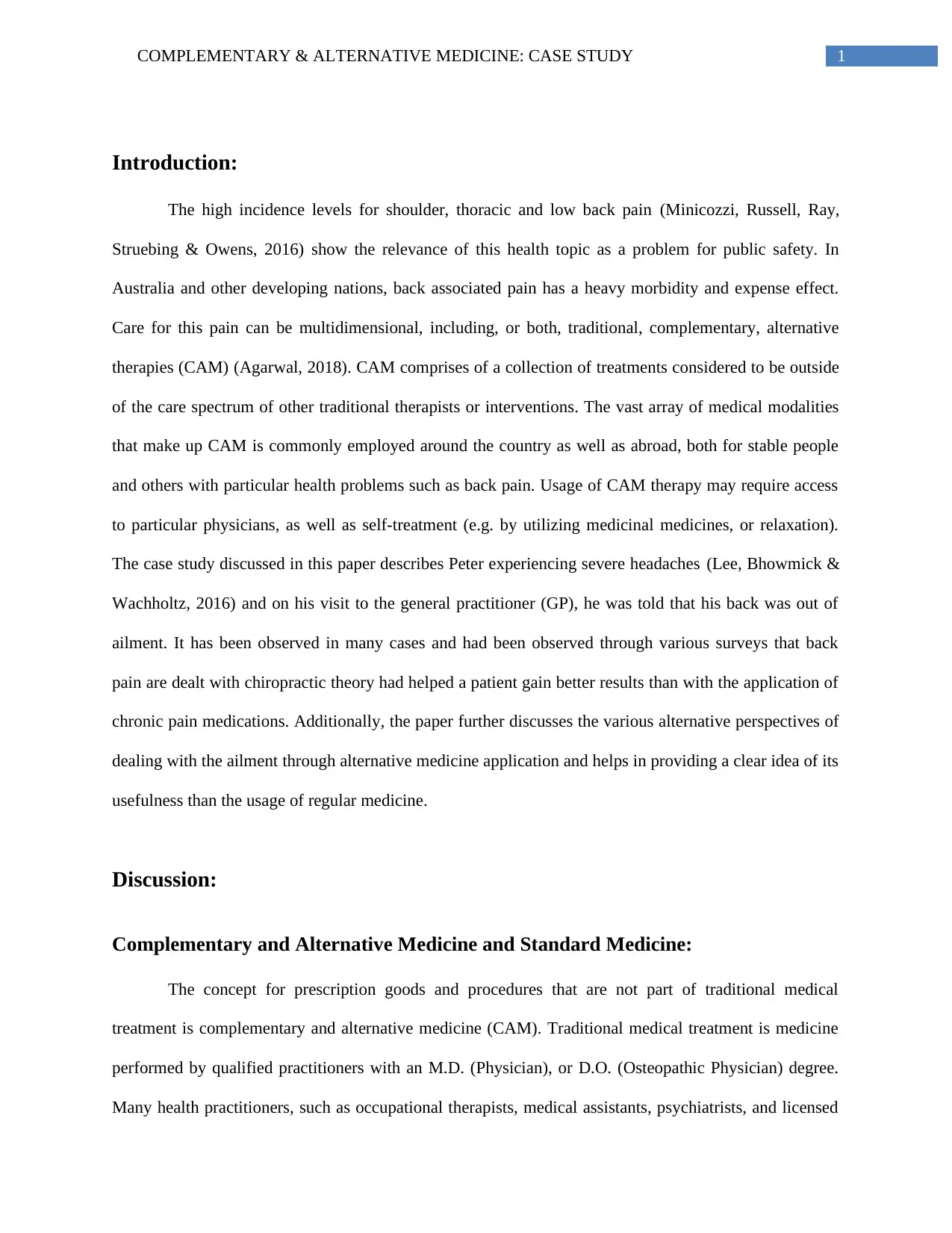
1COMPLEMENTARY & ALTERNATIVE MEDICINE: CASE STUDY
Introduction:
The high incidence levels for shoulder, thoracic and low back pain (Minicozzi, Russell, Ray,
Struebing & Owens, 2016) show the relevance of this health topic as a problem for public safety. In
Australia and other developing nations, back associated pain has a heavy morbidity and expense effect.
Care for this pain can be multidimensional, including, or both, traditional, complementary, alternative
therapies (CAM) (Agarwal, 2018). CAM comprises of a collection of treatments considered to be outside
of the care spectrum of other traditional therapists or interventions. The vast array of medical modalities
that make up CAM is commonly employed around the country as well as abroad, both for stable people
and others with particular health problems such as back pain. Usage of CAM therapy may require access
to particular physicians, as well as self-treatment (e.g. by utilizing medicinal medicines, or relaxation).
The case study discussed in this paper describes Peter experiencing severe headaches (Lee, Bhowmick &
Wachholtz, 2016) and on his visit to the general practitioner (GP), he was told that his back was out of
ailment. It has been observed in many cases and had been observed through various surveys that back
pain are dealt with chiropractic theory had helped a patient gain better results than with the application of
chronic pain medications. Additionally, the paper further discusses the various alternative perspectives of
dealing with the ailment through alternative medicine application and helps in providing a clear idea of its
usefulness than the usage of regular medicine.
Discussion:
Complementary and Alternative Medicine and Standard Medicine:
The concept for prescription goods and procedures that are not part of traditional medical
treatment is complementary and alternative medicine (CAM). Traditional medical treatment is medicine
performed by qualified practitioners with an M.D. (Physician), or D.O. (Osteopathic Physician) degree.
Many health practitioners, such as occupational therapists, medical assistants, psychiatrists, and licensed
Introduction:
The high incidence levels for shoulder, thoracic and low back pain (Minicozzi, Russell, Ray,
Struebing & Owens, 2016) show the relevance of this health topic as a problem for public safety. In
Australia and other developing nations, back associated pain has a heavy morbidity and expense effect.
Care for this pain can be multidimensional, including, or both, traditional, complementary, alternative
therapies (CAM) (Agarwal, 2018). CAM comprises of a collection of treatments considered to be outside
of the care spectrum of other traditional therapists or interventions. The vast array of medical modalities
that make up CAM is commonly employed around the country as well as abroad, both for stable people
and others with particular health problems such as back pain. Usage of CAM therapy may require access
to particular physicians, as well as self-treatment (e.g. by utilizing medicinal medicines, or relaxation).
The case study discussed in this paper describes Peter experiencing severe headaches (Lee, Bhowmick &
Wachholtz, 2016) and on his visit to the general practitioner (GP), he was told that his back was out of
ailment. It has been observed in many cases and had been observed through various surveys that back
pain are dealt with chiropractic theory had helped a patient gain better results than with the application of
chronic pain medications. Additionally, the paper further discusses the various alternative perspectives of
dealing with the ailment through alternative medicine application and helps in providing a clear idea of its
usefulness than the usage of regular medicine.
Discussion:
Complementary and Alternative Medicine and Standard Medicine:
The concept for prescription goods and procedures that are not part of traditional medical
treatment is complementary and alternative medicine (CAM). Traditional medical treatment is medicine
performed by qualified practitioners with an M.D. (Physician), or D.O. (Osteopathic Physician) degree.
Many health practitioners, such as occupational therapists, medical assistants, psychiatrists, and licensed
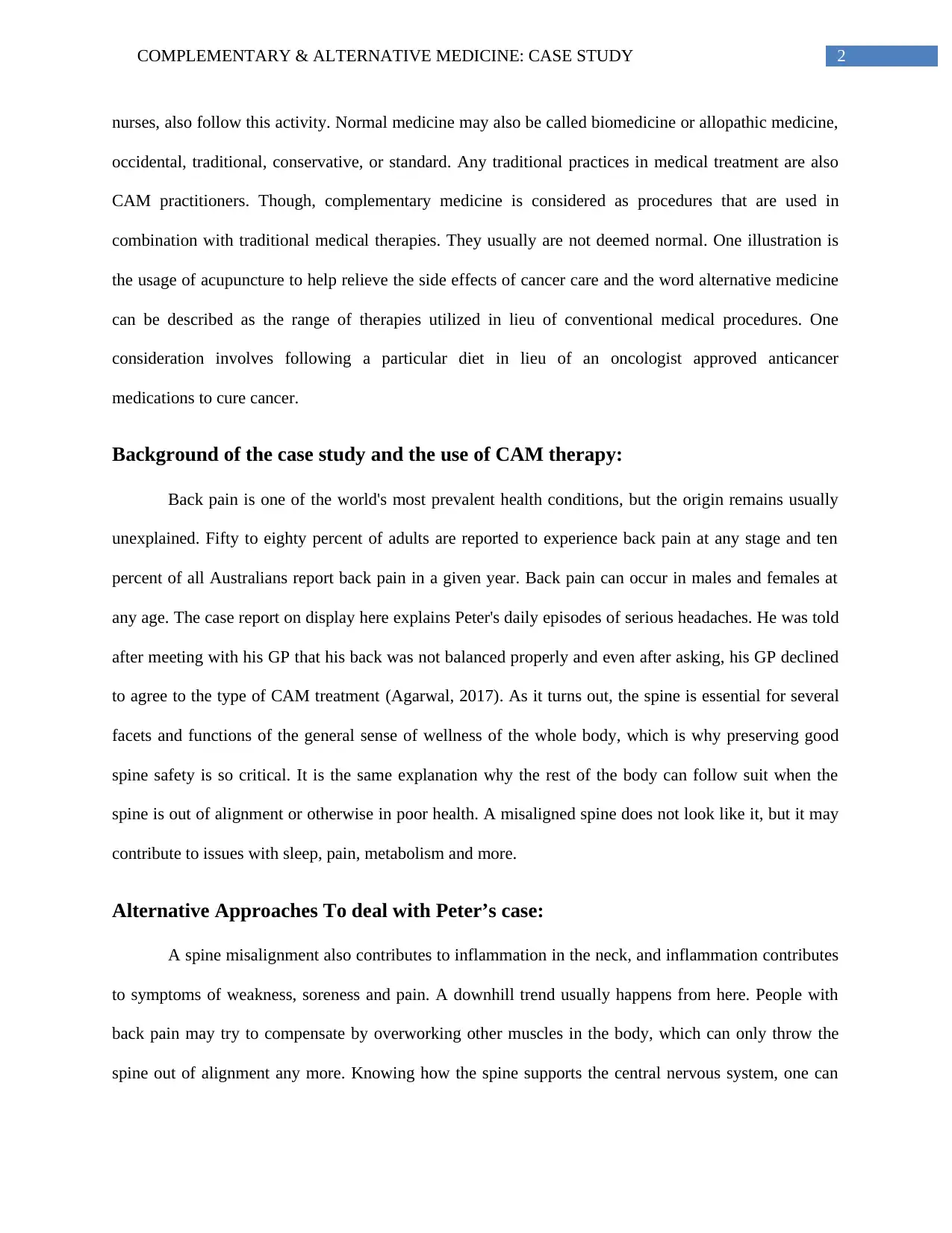
2COMPLEMENTARY & ALTERNATIVE MEDICINE: CASE STUDY
nurses, also follow this activity. Normal medicine may also be called biomedicine or allopathic medicine,
occidental, traditional, conservative, or standard. Any traditional practices in medical treatment are also
CAM practitioners. Though, complementary medicine is considered as procedures that are used in
combination with traditional medical therapies. They usually are not deemed normal. One illustration is
the usage of acupuncture to help relieve the side effects of cancer care and the word alternative medicine
can be described as the range of therapies utilized in lieu of conventional medical procedures. One
consideration involves following a particular diet in lieu of an oncologist approved anticancer
medications to cure cancer.
Background of the case study and the use of CAM therapy:
Back pain is one of the world's most prevalent health conditions, but the origin remains usually
unexplained. Fifty to eighty percent of adults are reported to experience back pain at any stage and ten
percent of all Australians report back pain in a given year. Back pain can occur in males and females at
any age. The case report on display here explains Peter's daily episodes of serious headaches. He was told
after meeting with his GP that his back was not balanced properly and even after asking, his GP declined
to agree to the type of CAM treatment (Agarwal, 2017). As it turns out, the spine is essential for several
facets and functions of the general sense of wellness of the whole body, which is why preserving good
spine safety is so critical. It is the same explanation why the rest of the body can follow suit when the
spine is out of alignment or otherwise in poor health. A misaligned spine does not look like it, but it may
contribute to issues with sleep, pain, metabolism and more.
Alternative Approaches To deal with Peter’s case:
A spine misalignment also contributes to inflammation in the neck, and inflammation contributes
to symptoms of weakness, soreness and pain. A downhill trend usually happens from here. People with
back pain may try to compensate by overworking other muscles in the body, which can only throw the
spine out of alignment any more. Knowing how the spine supports the central nervous system, one can
nurses, also follow this activity. Normal medicine may also be called biomedicine or allopathic medicine,
occidental, traditional, conservative, or standard. Any traditional practices in medical treatment are also
CAM practitioners. Though, complementary medicine is considered as procedures that are used in
combination with traditional medical therapies. They usually are not deemed normal. One illustration is
the usage of acupuncture to help relieve the side effects of cancer care and the word alternative medicine
can be described as the range of therapies utilized in lieu of conventional medical procedures. One
consideration involves following a particular diet in lieu of an oncologist approved anticancer
medications to cure cancer.
Background of the case study and the use of CAM therapy:
Back pain is one of the world's most prevalent health conditions, but the origin remains usually
unexplained. Fifty to eighty percent of adults are reported to experience back pain at any stage and ten
percent of all Australians report back pain in a given year. Back pain can occur in males and females at
any age. The case report on display here explains Peter's daily episodes of serious headaches. He was told
after meeting with his GP that his back was not balanced properly and even after asking, his GP declined
to agree to the type of CAM treatment (Agarwal, 2017). As it turns out, the spine is essential for several
facets and functions of the general sense of wellness of the whole body, which is why preserving good
spine safety is so critical. It is the same explanation why the rest of the body can follow suit when the
spine is out of alignment or otherwise in poor health. A misaligned spine does not look like it, but it may
contribute to issues with sleep, pain, metabolism and more.
Alternative Approaches To deal with Peter’s case:
A spine misalignment also contributes to inflammation in the neck, and inflammation contributes
to symptoms of weakness, soreness and pain. A downhill trend usually happens from here. People with
back pain may try to compensate by overworking other muscles in the body, which can only throw the
spine out of alignment any more. Knowing how the spine supports the central nervous system, one can
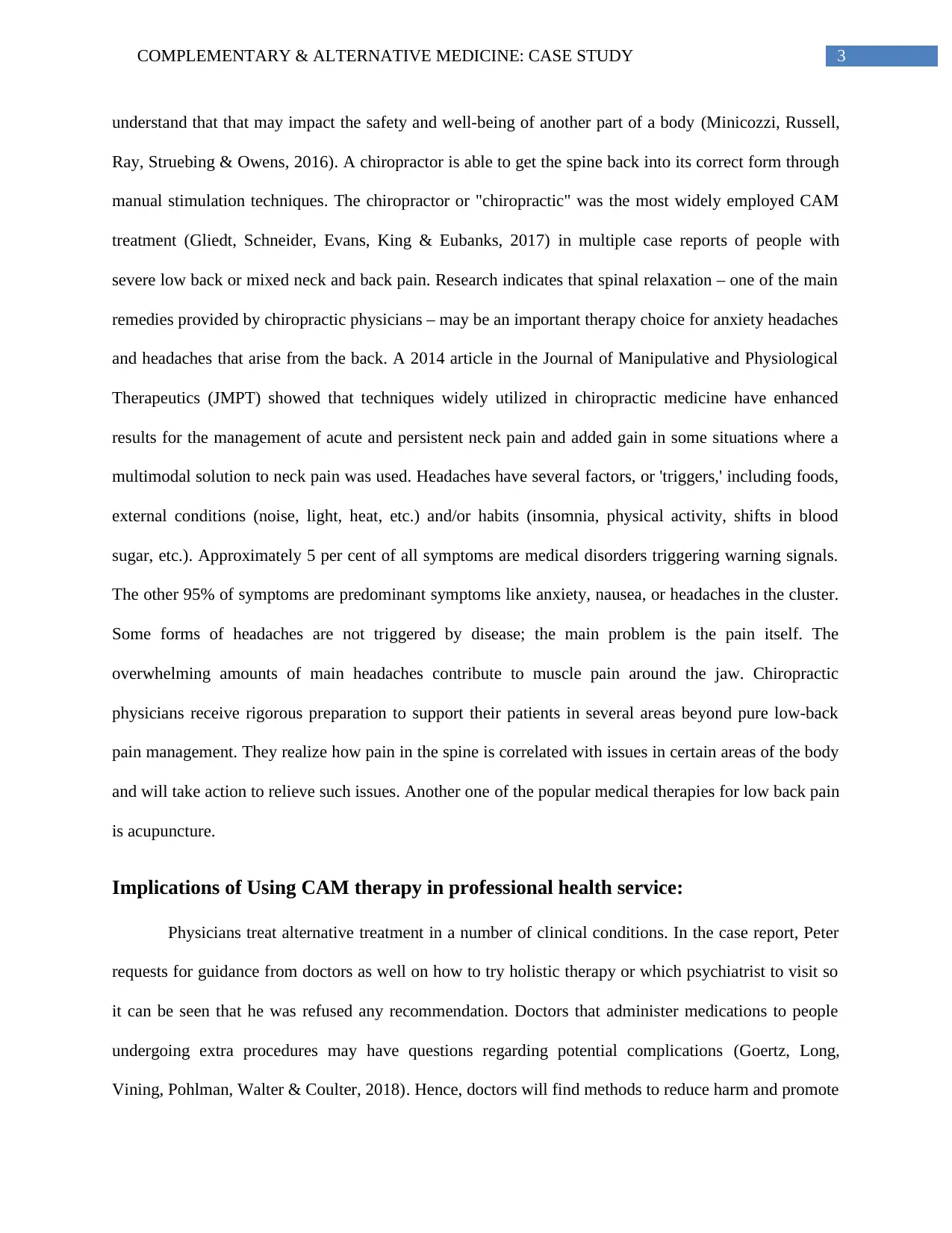
3COMPLEMENTARY & ALTERNATIVE MEDICINE: CASE STUDY
understand that that may impact the safety and well-being of another part of a body (Minicozzi, Russell,
Ray, Struebing & Owens, 2016). A chiropractor is able to get the spine back into its correct form through
manual stimulation techniques. The chiropractor or "chiropractic" was the most widely employed CAM
treatment (Gliedt, Schneider, Evans, King & Eubanks, 2017) in multiple case reports of people with
severe low back or mixed neck and back pain. Research indicates that spinal relaxation – one of the main
remedies provided by chiropractic physicians – may be an important therapy choice for anxiety headaches
and headaches that arise from the back. A 2014 article in the Journal of Manipulative and Physiological
Therapeutics (JMPT) showed that techniques widely utilized in chiropractic medicine have enhanced
results for the management of acute and persistent neck pain and added gain in some situations where a
multimodal solution to neck pain was used. Headaches have several factors, or 'triggers,' including foods,
external conditions (noise, light, heat, etc.) and/or habits (insomnia, physical activity, shifts in blood
sugar, etc.). Approximately 5 per cent of all symptoms are medical disorders triggering warning signals.
The other 95% of symptoms are predominant symptoms like anxiety, nausea, or headaches in the cluster.
Some forms of headaches are not triggered by disease; the main problem is the pain itself. The
overwhelming amounts of main headaches contribute to muscle pain around the jaw. Chiropractic
physicians receive rigorous preparation to support their patients in several areas beyond pure low-back
pain management. They realize how pain in the spine is correlated with issues in certain areas of the body
and will take action to relieve such issues. Another one of the popular medical therapies for low back pain
is acupuncture.
Implications of Using CAM therapy in professional health service:
Physicians treat alternative treatment in a number of clinical conditions. In the case report, Peter
requests for guidance from doctors as well on how to try holistic therapy or which psychiatrist to visit so
it can be seen that he was refused any recommendation. Doctors that administer medications to people
undergoing extra procedures may have questions regarding potential complications (Goertz, Long,
Vining, Pohlman, Walter & Coulter, 2018). Hence, doctors will find methods to reduce harm and promote
understand that that may impact the safety and well-being of another part of a body (Minicozzi, Russell,
Ray, Struebing & Owens, 2016). A chiropractor is able to get the spine back into its correct form through
manual stimulation techniques. The chiropractor or "chiropractic" was the most widely employed CAM
treatment (Gliedt, Schneider, Evans, King & Eubanks, 2017) in multiple case reports of people with
severe low back or mixed neck and back pain. Research indicates that spinal relaxation – one of the main
remedies provided by chiropractic physicians – may be an important therapy choice for anxiety headaches
and headaches that arise from the back. A 2014 article in the Journal of Manipulative and Physiological
Therapeutics (JMPT) showed that techniques widely utilized in chiropractic medicine have enhanced
results for the management of acute and persistent neck pain and added gain in some situations where a
multimodal solution to neck pain was used. Headaches have several factors, or 'triggers,' including foods,
external conditions (noise, light, heat, etc.) and/or habits (insomnia, physical activity, shifts in blood
sugar, etc.). Approximately 5 per cent of all symptoms are medical disorders triggering warning signals.
The other 95% of symptoms are predominant symptoms like anxiety, nausea, or headaches in the cluster.
Some forms of headaches are not triggered by disease; the main problem is the pain itself. The
overwhelming amounts of main headaches contribute to muscle pain around the jaw. Chiropractic
physicians receive rigorous preparation to support their patients in several areas beyond pure low-back
pain management. They realize how pain in the spine is correlated with issues in certain areas of the body
and will take action to relieve such issues. Another one of the popular medical therapies for low back pain
is acupuncture.
Implications of Using CAM therapy in professional health service:
Physicians treat alternative treatment in a number of clinical conditions. In the case report, Peter
requests for guidance from doctors as well on how to try holistic therapy or which psychiatrist to visit so
it can be seen that he was refused any recommendation. Doctors that administer medications to people
undergoing extra procedures may have questions regarding potential complications (Goertz, Long,
Vining, Pohlman, Walter & Coulter, 2018). Hence, doctors will find methods to reduce harm and promote
Secure Best Marks with AI Grader
Need help grading? Try our AI Grader for instant feedback on your assignments.
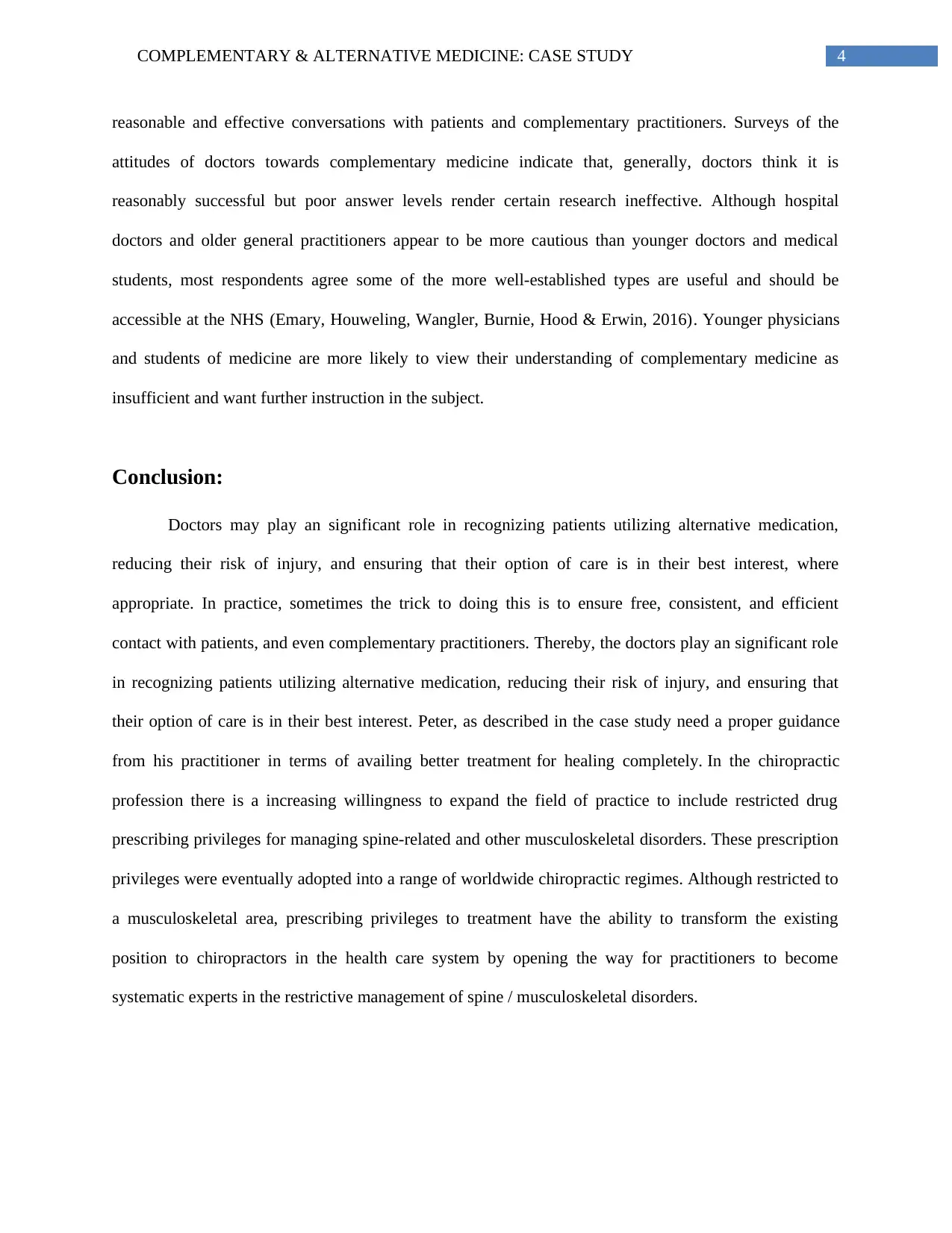
4COMPLEMENTARY & ALTERNATIVE MEDICINE: CASE STUDY
reasonable and effective conversations with patients and complementary practitioners. Surveys of the
attitudes of doctors towards complementary medicine indicate that, generally, doctors think it is
reasonably successful but poor answer levels render certain research ineffective. Although hospital
doctors and older general practitioners appear to be more cautious than younger doctors and medical
students, most respondents agree some of the more well-established types are useful and should be
accessible at the NHS (Emary, Houweling, Wangler, Burnie, Hood & Erwin, 2016). Younger physicians
and students of medicine are more likely to view their understanding of complementary medicine as
insufficient and want further instruction in the subject.
Conclusion:
Doctors may play an significant role in recognizing patients utilizing alternative medication,
reducing their risk of injury, and ensuring that their option of care is in their best interest, where
appropriate. In practice, sometimes the trick to doing this is to ensure free, consistent, and efficient
contact with patients, and even complementary practitioners. Thereby, the doctors play an significant role
in recognizing patients utilizing alternative medication, reducing their risk of injury, and ensuring that
their option of care is in their best interest. Peter, as described in the case study need a proper guidance
from his practitioner in terms of availing better treatment for healing completely. In the chiropractic
profession there is a increasing willingness to expand the field of practice to include restricted drug
prescribing privileges for managing spine-related and other musculoskeletal disorders. These prescription
privileges were eventually adopted into a range of worldwide chiropractic regimes. Although restricted to
a musculoskeletal area, prescribing privileges to treatment have the ability to transform the existing
position to chiropractors in the health care system by opening the way for practitioners to become
systematic experts in the restrictive management of spine / musculoskeletal disorders.
reasonable and effective conversations with patients and complementary practitioners. Surveys of the
attitudes of doctors towards complementary medicine indicate that, generally, doctors think it is
reasonably successful but poor answer levels render certain research ineffective. Although hospital
doctors and older general practitioners appear to be more cautious than younger doctors and medical
students, most respondents agree some of the more well-established types are useful and should be
accessible at the NHS (Emary, Houweling, Wangler, Burnie, Hood & Erwin, 2016). Younger physicians
and students of medicine are more likely to view their understanding of complementary medicine as
insufficient and want further instruction in the subject.
Conclusion:
Doctors may play an significant role in recognizing patients utilizing alternative medication,
reducing their risk of injury, and ensuring that their option of care is in their best interest, where
appropriate. In practice, sometimes the trick to doing this is to ensure free, consistent, and efficient
contact with patients, and even complementary practitioners. Thereby, the doctors play an significant role
in recognizing patients utilizing alternative medication, reducing their risk of injury, and ensuring that
their option of care is in their best interest. Peter, as described in the case study need a proper guidance
from his practitioner in terms of availing better treatment for healing completely. In the chiropractic
profession there is a increasing willingness to expand the field of practice to include restricted drug
prescribing privileges for managing spine-related and other musculoskeletal disorders. These prescription
privileges were eventually adopted into a range of worldwide chiropractic regimes. Although restricted to
a musculoskeletal area, prescribing privileges to treatment have the ability to transform the existing
position to chiropractors in the health care system by opening the way for practitioners to become
systematic experts in the restrictive management of spine / musculoskeletal disorders.
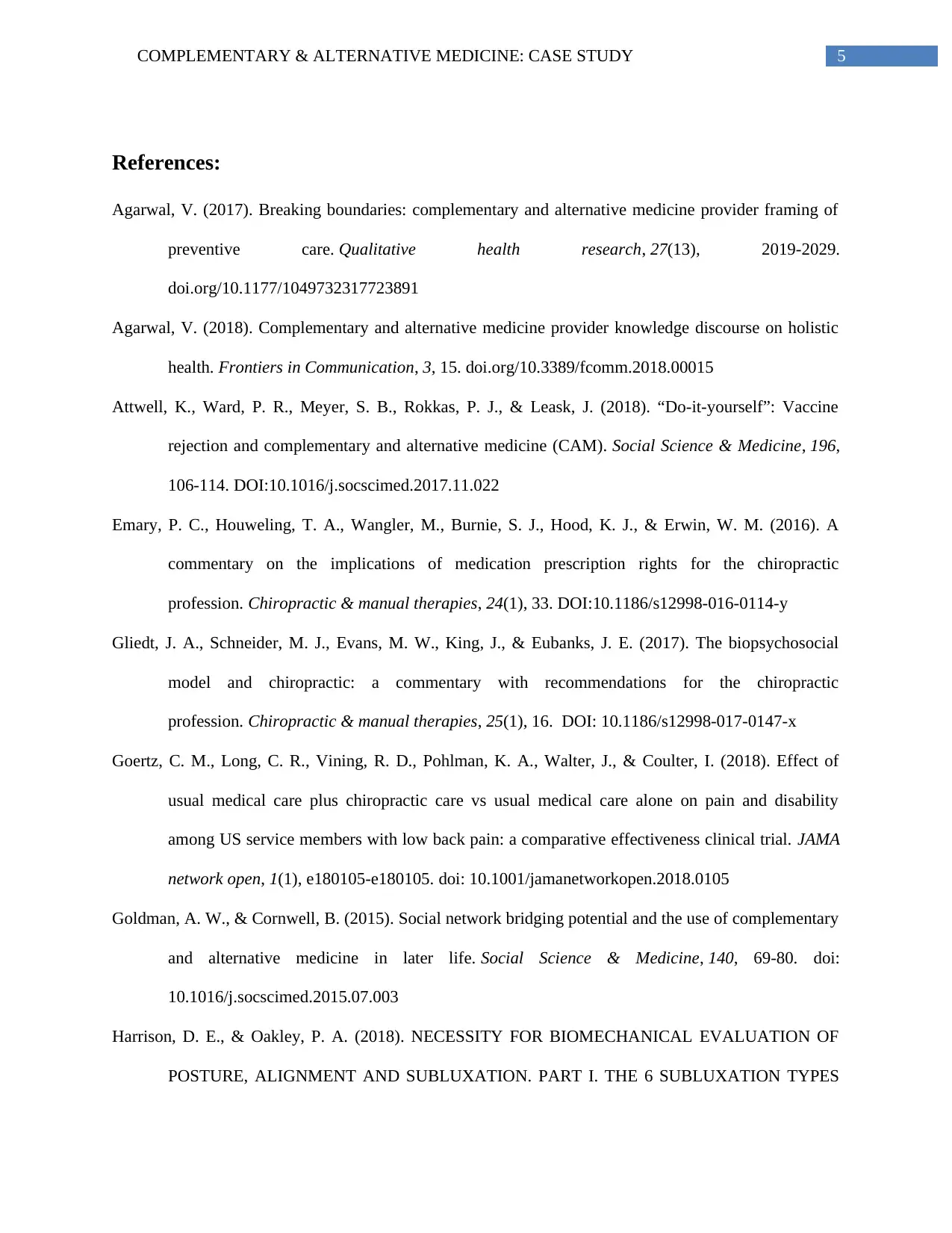
5COMPLEMENTARY & ALTERNATIVE MEDICINE: CASE STUDY
References:
Agarwal, V. (2017). Breaking boundaries: complementary and alternative medicine provider framing of
preventive care. Qualitative health research, 27(13), 2019-2029.
doi.org/10.1177/1049732317723891
Agarwal, V. (2018). Complementary and alternative medicine provider knowledge discourse on holistic
health. Frontiers in Communication, 3, 15. doi.org/10.3389/fcomm.2018.00015
Attwell, K., Ward, P. R., Meyer, S. B., Rokkas, P. J., & Leask, J. (2018). “Do-it-yourself”: Vaccine
rejection and complementary and alternative medicine (CAM). Social Science & Medicine, 196,
106-114. DOI:10.1016/j.socscimed.2017.11.022
Emary, P. C., Houweling, T. A., Wangler, M., Burnie, S. J., Hood, K. J., & Erwin, W. M. (2016). A
commentary on the implications of medication prescription rights for the chiropractic
profession. Chiropractic & manual therapies, 24(1), 33. DOI:10.1186/s12998-016-0114-y
Gliedt, J. A., Schneider, M. J., Evans, M. W., King, J., & Eubanks, J. E. (2017). The biopsychosocial
model and chiropractic: a commentary with recommendations for the chiropractic
profession. Chiropractic & manual therapies, 25(1), 16. DOI: 10.1186/s12998-017-0147-x
Goertz, C. M., Long, C. R., Vining, R. D., Pohlman, K. A., Walter, J., & Coulter, I. (2018). Effect of
usual medical care plus chiropractic care vs usual medical care alone on pain and disability
among US service members with low back pain: a comparative effectiveness clinical trial. JAMA
network open, 1(1), e180105-e180105. doi: 10.1001/jamanetworkopen.2018.0105
Goldman, A. W., & Cornwell, B. (2015). Social network bridging potential and the use of complementary
and alternative medicine in later life. Social Science & Medicine, 140, 69-80. doi:
10.1016/j.socscimed.2015.07.003
Harrison, D. E., & Oakley, P. A. (2018). NECESSITY FOR BIOMECHANICAL EVALUATION OF
POSTURE, ALIGNMENT AND SUBLUXATION. PART I. THE 6 SUBLUXATION TYPES
References:
Agarwal, V. (2017). Breaking boundaries: complementary and alternative medicine provider framing of
preventive care. Qualitative health research, 27(13), 2019-2029.
doi.org/10.1177/1049732317723891
Agarwal, V. (2018). Complementary and alternative medicine provider knowledge discourse on holistic
health. Frontiers in Communication, 3, 15. doi.org/10.3389/fcomm.2018.00015
Attwell, K., Ward, P. R., Meyer, S. B., Rokkas, P. J., & Leask, J. (2018). “Do-it-yourself”: Vaccine
rejection and complementary and alternative medicine (CAM). Social Science & Medicine, 196,
106-114. DOI:10.1016/j.socscimed.2017.11.022
Emary, P. C., Houweling, T. A., Wangler, M., Burnie, S. J., Hood, K. J., & Erwin, W. M. (2016). A
commentary on the implications of medication prescription rights for the chiropractic
profession. Chiropractic & manual therapies, 24(1), 33. DOI:10.1186/s12998-016-0114-y
Gliedt, J. A., Schneider, M. J., Evans, M. W., King, J., & Eubanks, J. E. (2017). The biopsychosocial
model and chiropractic: a commentary with recommendations for the chiropractic
profession. Chiropractic & manual therapies, 25(1), 16. DOI: 10.1186/s12998-017-0147-x
Goertz, C. M., Long, C. R., Vining, R. D., Pohlman, K. A., Walter, J., & Coulter, I. (2018). Effect of
usual medical care plus chiropractic care vs usual medical care alone on pain and disability
among US service members with low back pain: a comparative effectiveness clinical trial. JAMA
network open, 1(1), e180105-e180105. doi: 10.1001/jamanetworkopen.2018.0105
Goldman, A. W., & Cornwell, B. (2015). Social network bridging potential and the use of complementary
and alternative medicine in later life. Social Science & Medicine, 140, 69-80. doi:
10.1016/j.socscimed.2015.07.003
Harrison, D. E., & Oakley, P. A. (2018). NECESSITY FOR BIOMECHANICAL EVALUATION OF
POSTURE, ALIGNMENT AND SUBLUXATION. PART I. THE 6 SUBLUXATION TYPES
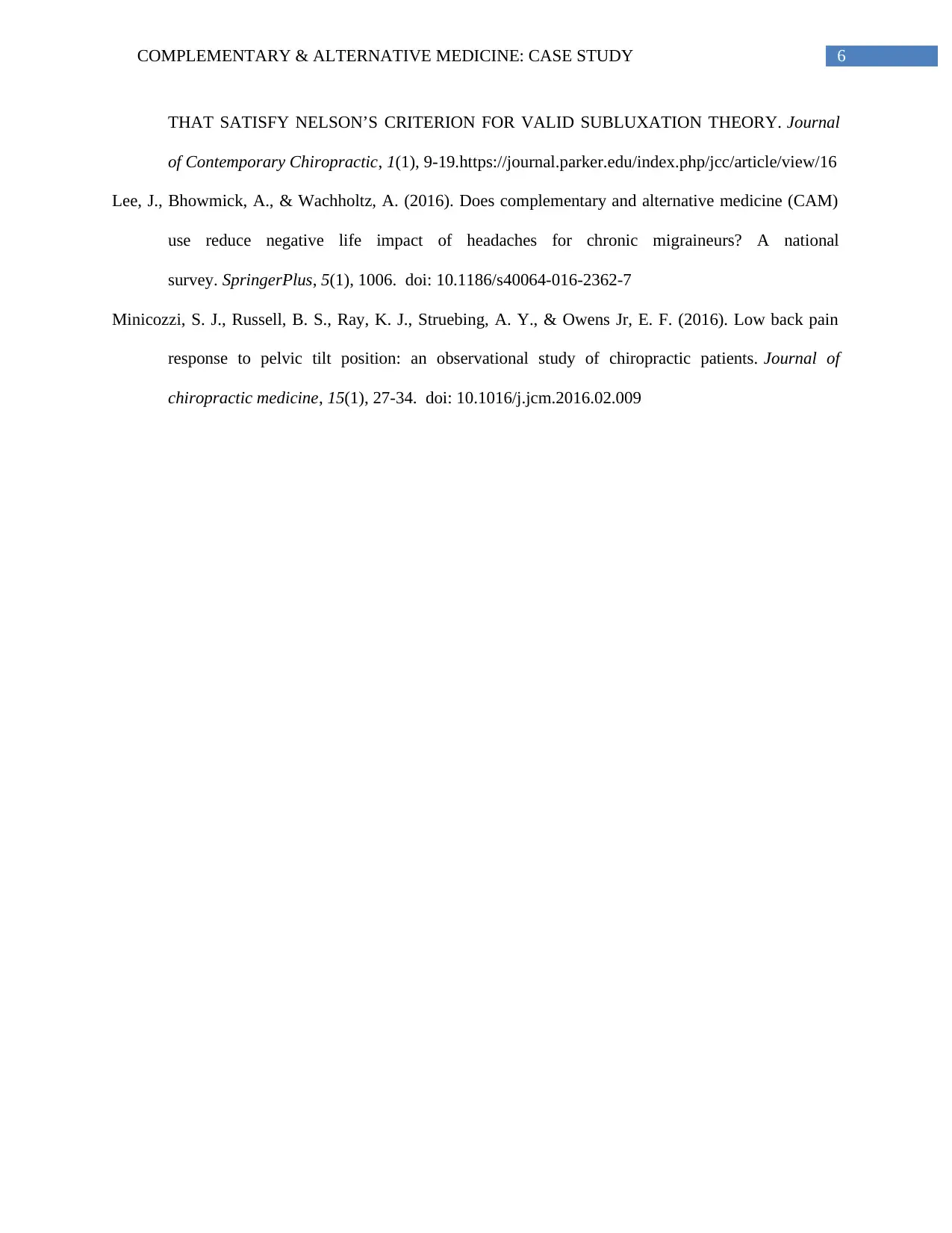
6COMPLEMENTARY & ALTERNATIVE MEDICINE: CASE STUDY
THAT SATISFY NELSON’S CRITERION FOR VALID SUBLUXATION THEORY. Journal
of Contemporary Chiropractic, 1(1), 9-19.https://journal.parker.edu/index.php/jcc/article/view/16
Lee, J., Bhowmick, A., & Wachholtz, A. (2016). Does complementary and alternative medicine (CAM)
use reduce negative life impact of headaches for chronic migraineurs? A national
survey. SpringerPlus, 5(1), 1006. doi: 10.1186/s40064-016-2362-7
Minicozzi, S. J., Russell, B. S., Ray, K. J., Struebing, A. Y., & Owens Jr, E. F. (2016). Low back pain
response to pelvic tilt position: an observational study of chiropractic patients. Journal of
chiropractic medicine, 15(1), 27-34. doi: 10.1016/j.jcm.2016.02.009
THAT SATISFY NELSON’S CRITERION FOR VALID SUBLUXATION THEORY. Journal
of Contemporary Chiropractic, 1(1), 9-19.https://journal.parker.edu/index.php/jcc/article/view/16
Lee, J., Bhowmick, A., & Wachholtz, A. (2016). Does complementary and alternative medicine (CAM)
use reduce negative life impact of headaches for chronic migraineurs? A national
survey. SpringerPlus, 5(1), 1006. doi: 10.1186/s40064-016-2362-7
Minicozzi, S. J., Russell, B. S., Ray, K. J., Struebing, A. Y., & Owens Jr, E. F. (2016). Low back pain
response to pelvic tilt position: an observational study of chiropractic patients. Journal of
chiropractic medicine, 15(1), 27-34. doi: 10.1016/j.jcm.2016.02.009
1 out of 7
Related Documents
Your All-in-One AI-Powered Toolkit for Academic Success.
+13062052269
info@desklib.com
Available 24*7 on WhatsApp / Email
![[object Object]](/_next/static/media/star-bottom.7253800d.svg)
Unlock your academic potential
© 2024 | Zucol Services PVT LTD | All rights reserved.





